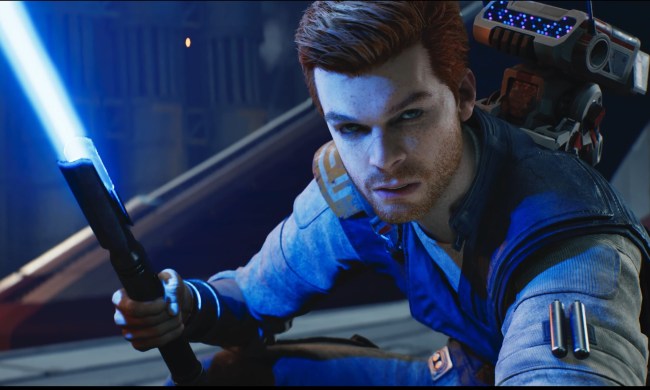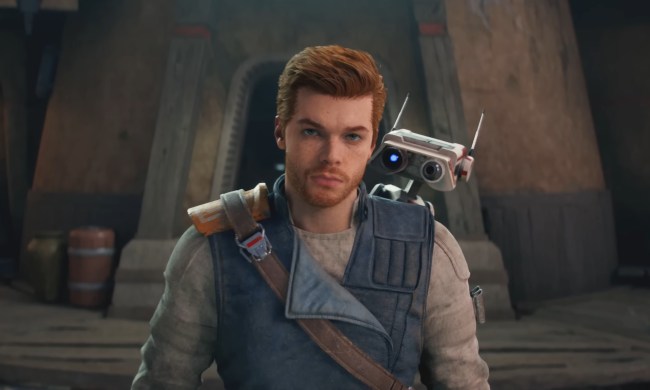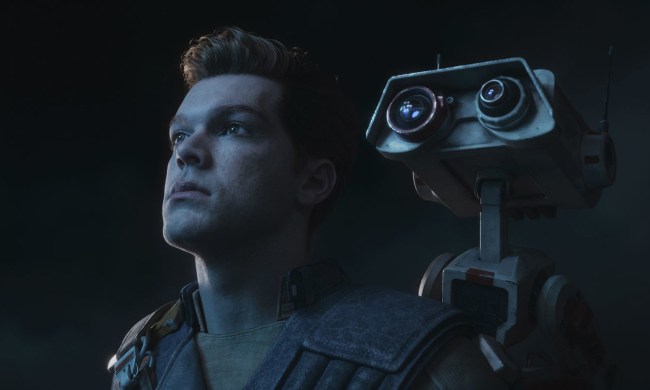“Star Wars Jedi: Survivor is bigger and more densely detailed that Fallen Order in almost every way, but it still tells a personal story.”
- Engaging, darker narrative
- Improved combat and exploration
- Expansion of Pyloon's Saloon
- Beautiful visuals
- Pacing issues
- Technical problems
The first shot of Respawn Entertainment’s Star Wars Jedi: Survivor is one of Coruscant’s Jedi Temple adorned with Imperial Banners. Zipping past it before a heist on the planet that once served as the Jedi’s base of operations, the heroic Cal Kestis looks visibly upset. The image is a reminder of why the young Jedi can’t move on until his mission is complete; he doesn’t care what else is in his way or what happens to himself, as long as Jedi populate that temple again. And that desire comes at the cost of other parts of his life, and potentially, the future of the Jedi Order.
That overwhelming sense of dread is common in Star Wars sequels, especially the second installments of its trilogies. The Empire Strikes Back’s opening on Hoth became iconic, and it was one of the first blockbusters where our heroes didn’t really win at the end. Star Wars: The Last Jedi made The First Order and The Dark Side feel like an inescapable force that Rey and the Resistance would have to overcome.
Just as those films showed that their respective conflicts were far from over after the triumphant wins in their predecessors, Survivor is dealing with the same aftermath following a much more muted victory at the end of Star Wars Jedi: Fallen Order. That allows this game to dive deeper into these themes than any other Star Wars product, telling a story about people who feel so overwhelmed by a sense of obligation that there’s no way out.

That results in a poignant Star Wars story sitting at the center of a meaty single-player adventure. While its pacing lags a bit in the middle and some performance issues dampen a truly next-gen-feeling game, Star Wars Jedi: Survivor still tells a thematically rich, character-driven Jedi tale in one of the most densely packed 3D Metroidvania games I’ve ever played. It’s now the definitive single-player Star Wars experience.
Dark forces
In many ways, Survivor feels like last year’s God of War: Ragnarok. It’s a sequel that, both in terms of gameplay and narrative, can feel more like part two of a grander story. The narrative is set five years after the events of Fallen Order, and in that time, the Mantis crew from the original game has drifted apart. Now sporting a beard and more battle scars, Cal has been fighting endless battles with the Empire for Saw Gerrera. After a heist on Coruscant goes wrong, he ends up on the planet of Koboh, where Mantis pilot Greez now runs a Cantina. After a few chance encounters and some begging from Greez to settle down, Cal discovers Dagan Gera, a Jedi who has been preserved in a Bacta Tank since the High Republic era.
It’s a surprisingly personal journey …
Unfortunately, Gera quickly turns on Cal, turning to the dark side in his quest to get to the planet of Tanalorr, which is hidden from the grasp of the Empire behind a dangerous abyss. This is what truly kicks off the adventure, which sees Cal reunite with his mentor, Cere, as well as his Nightsister crush and badass Magick user Merrin, and a new bounty hunter friend named Bode, who feels obligated to fight for a better future for his daughter. It’s a surprisingly personal journey, with Dagan Gera being a worrying reflection of how Cal could end up if he continues down his current path.
Both feel some sort of obligation based on a sense of grief. Does Cal deserve to settle down and be happy with those he loves if the Empire that destroyed the Jedi Order is still around? Should Dagan give up his ambition to find Tanalorr after all he’s sacrificed and everyone he’s betrayed to get here? These are some of the thoughtful questions Survivor asks, confronting the more personal, mental health-related consequences of the lingering dread and grief often present in direct Star Wars sequels.
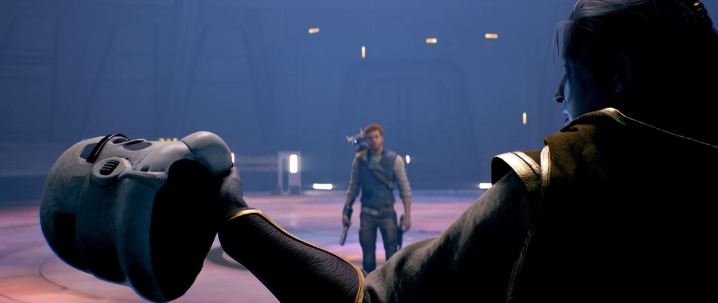
Without spoiling the narrative’s major twists (of which there are a few), Cal ultimately has to learn healthier ways to deal with grief and that true friends are willing to help. Thinking back to the ending of Fallen Order, the Mantis Crew didn’t necessarily defeat a part of the Empire at the end of the first game, but it helped others by preventing the Empire from finding a lot of force-sensitive people. Cal needs to relearn that positive actions that help others like this are what really make a difference.
Still, it doesn’t forget that Star Wars can be campy and fun. Many of the conversations I overheard before ambushing enemies had me laughing. One particular moment that stands out was when two droids were boasting about how they could easily beat a Jedi, only for one of them to immediately say “lowering expectations” as soon as I attacked. Respawn Entertainment recognizes that these little moments of levity do wonders in between the game’s more dire and dramatic moments where Cal feels the weight of the galaxy on his shoulders.
Battlefront
Cal’s personal journey is reflected in gameplay through Survivor‘s new companion system. During many of the game’s story segments, Bode or Merrin will fight alongside Cal and can be issued simple attack commands that primarily help to stun enemies. For the most part, though, gameplay in this sequel expands to go bigger and better, fixing minor problems with Fallen Order. Like its predecessor, Survivor takes a methodical approach to its lightsaber combat, emphasizing well-timed parries, dodges, strikes, and force powers. The number of stances Cal can fight in has increased to five, with two equipped at any time.
This feels like the deepest “Jedi simulator” we’ve ever gotten from a Star Wars game.
I mostly used the brand new Crossguard stance (based on Kylo Ren’s lightsaber and fighting style) and its slow but impactful attacks for one-on-one battles. And the Double-Bladed stance that could attack a wide area quickly came in handy whenever enemies surrounded me. If you used the Wild Gunman stance in Like a Dragon! Ishin earlier this year, you should try out the Blaster stance that gives Cal a lightsaber and blaster simultaneously.
Combat is just as fun as in Fallen Order, and Cal’s moveset only gets better over time thanks to several skill trees that players upgrade throughout the game and equippable perks. A wide variety of difficulty and accessibility options also make the experience helpfully tailorable on both sides of the difficulty spectrum. Even with its darker tone and heavier themes, this feels like the deepest “Jedi simulator” we’ve ever gotten from a Star Wars game.
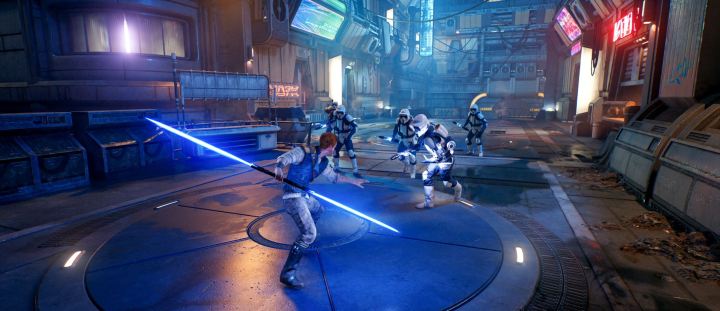
Survivor’s narrative themes come through in another major gameplay centerpiece: Pyloon’s Saloon. Initially a tiny rough-and-tumble dive on the planet of Koboh, Cal can invite people back to the aaloon and the surrounding area, opening up new conversations, vendors, and even minigames like gardening and a Holotactics strategy game. Watching Pyloon’s Saloon get more lively throughout the adventure gives a clear sense of progression, but it plays into the fact that Cal is doing more for the galaxy in the long term when he’s making connections and helping others thrive, not just dedicating every waking moment to attacks on the Empire.
Admittedly, the depth of this side content isn’t wholly consistent. Gardening is a little restrictive and doesn’t have many rewards outside of new dialogue and more space to garden, while Holotactics feels up to chance once units are placed (it even soft-locked on me a couple of times). Survivor strives for depth, detail, and quantity of content, and for the most part, it meets that goal without sacrificing quality, but it also results in some optional features feeling underbaked.
Metroidvania done right
Where that added sense of depth and detail is more appreciated is the Metroidvania side of the adventure, which has evolved the most since Fallen Order. This is the most densely packed AAA 3D Metroidvania since Batman: Arkham Asylum. There aren’t a lot of planets to explore — I spent most of my playtime on Koboh and Jedha — but each is an impressive hub densely packed with details and places to discover. Even after finishing the main story, most of these hubs were only about 60% complete in my file, encouraging me to come back frequently as my skill set expanded. Cal obtains some new movement options during his adventure, like the ability to dash in the air and yank objects up and down. In more open-ended maps, players can even find mounts to ride and glide around with.

These things all open up new pathways in the world that are exhilarating to overcome. Still, Survivor’s level design still feels naturalistic, with Cal climbing up worn-down rocky cliffsides or navigating through Imperial equipment that reinforces the Empire’s everlasting negative impact on the galaxy.
For those most interested in Survivor’s narrative, this setup can come at the cost of pacing. The high stakes and sense of dread are dampened somewhat as Cal spends a little bit of extra time hopping around solving Breath of the Wild shrine-like challenges scattered across Koboh and Jedha or needing to make an extra long detour because a shortcut isn’t open yet. Fallen Order has a similar pacing issue, where the middle portion of the game relies on the most galaxy-trodding Metroidvania-like diversions that make getting from point A to point B just a little too long.
The delivery of its compelling, emotional narrative could’ve been tighter than it is across 20 hours here.
Survivor remains a lot of fun to play in these moments, though, and you’ll definitely get your money’s worth out of this adventure before and after you finish its main story. However, the delivery of its compelling, emotional narrative could have been tighter than it is across 20 hours here. While its winding passages can get a bit tiring in some of the laxer narrative moments, Survivor’s locales all feel incredibly well-realized and respectful to the Star Wars universe.
Shadow of the Empire
It helps that the game looks excellent. Survivor is only available on current-gen systems, and the reasoning for that becomes apparent when walking through the extremely detailed streets of Coruscant or taking in the immaculate detail in an Imperial or High Republic facility. Unfortunately, the frame rate does struggle with that power. I played Survivor in performance mode and noticed quite a bit of stuttering in some effects-heavy situations; the frame rate change when entering cutscenes was also notable and sometimes jarring.
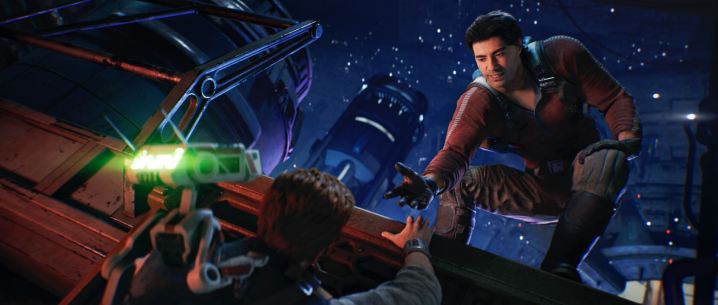
It’s worth noting that the game crashed twice on me during my adventure, which is notable considering that issues like that were Fallen Order‘s Achilles’ heel. These are issues that the developers could mend with patches at and after launch, but just as Cal can never escape the shadow of the Empire, Survivor shows that even “next-gen”-looking games still can’t outrun some technical issues. Thankfully, I barely ran into any of the game-breaking bugs that plagued Fallen Order at release.
Even after I beat the game, that image of the Jedi temple adorned with Imperial banners still graces the title screen. This is still several years before Luke Skywalker and his friends would actually rid the galaxy of the Empire, but that doesn’t make Cal’s actions any less meaningful. Cal’s journey follows the thematic trends established by The Empire Strikes Back and The Last Jedi, but is willing to get even more personal with them in a way only a game can. This, coupled with its deeper combat and more densely packed worlds, truly put me in the mindset of a Jedi during this dire era.
Star Wars Jedi: Survivor doesn’t reinvent the formula of Fallen Order and still suffers from some pacing and technical issues as that game did. Still, it’s one of the best single-player Star Wars experiences that I’ve ever played. The Empire may not be defeated by the end of Survivor, but I enjoyed exploring this beautiful galaxy and watching Cal open up along the way.
Star Wars Jedi: Survivor was reviewed on PlayStation 5.



